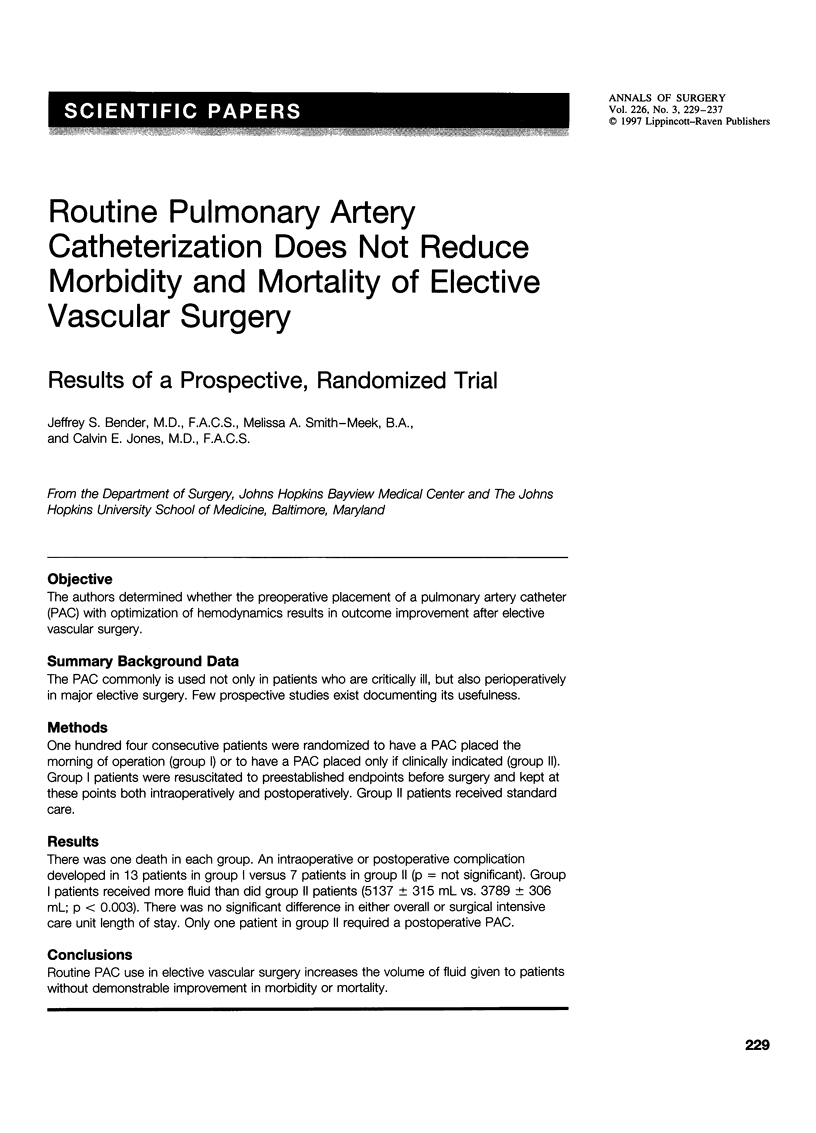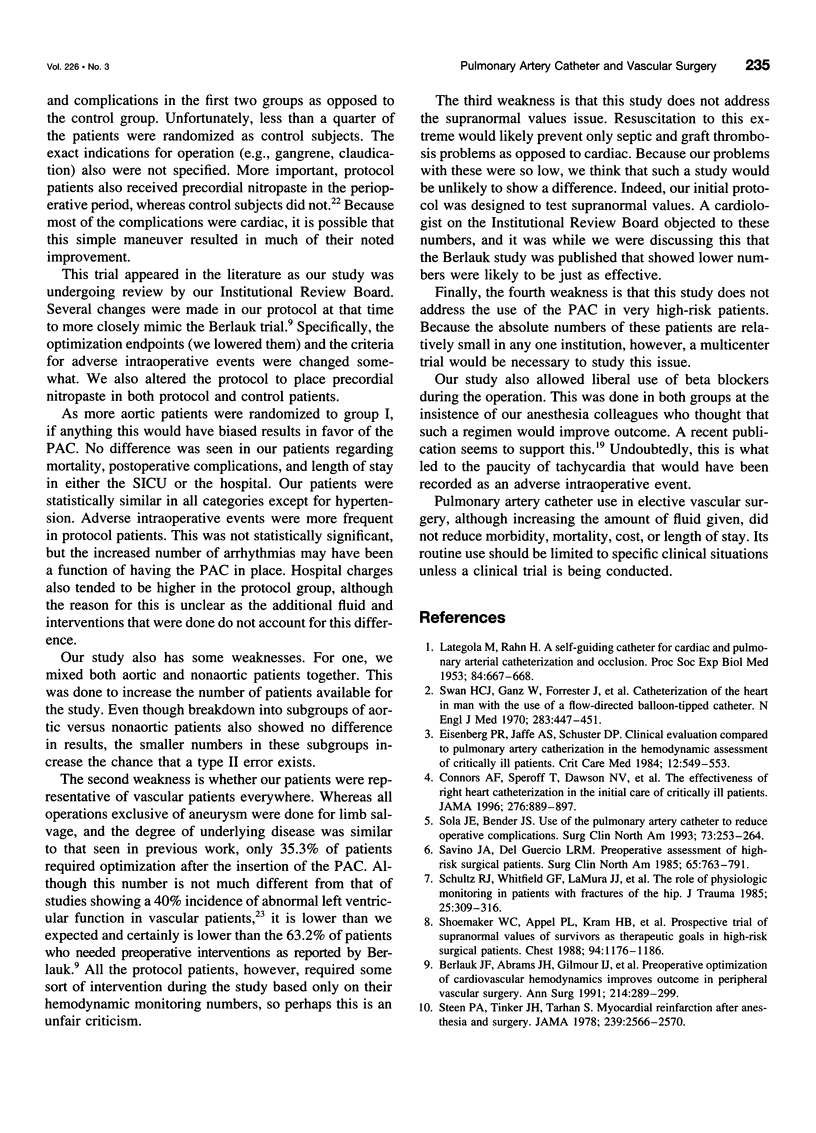Abstract
OBJECTIVE: The authors determined whether the preoperative placement of a pulmonary artery catheter (PAC) with optimization of hemodynamics results in outcome improvement after elective vascular surgery. SUMMARY BACKGROUND DATA: The PAC commonly is used not only in patients who are critically ill, but also perioperatively in major elective surgery. Few prospective studies exist documenting its usefulness. METHODS: One hundred four consecutive patients were randomized to have a PAC placed the morning of operation (group I) or to have a PAC placed only if clinically indicated (group II). Group I patients were resuscitated to preestablished endpoints before surgery and kept at these points both intraoperatively and postoperatively. Group II patients received standard care. RESULTS: There was one death in each group. An intraoperative or postoperative complication developed in 13 patients in group I versus 7 patients in group II (p = not significant). Group I patients received more fluid than did group II patients (5137 +/- 315 mL vs. 3789 +/- 306 mL; p < 0.003). There was no significant difference in either overall or surgical intensive care unit length of stay. Only one patient in group II required a postoperative PAC. CONCLUSIONS: Routine PAC use in elective vascular surgery increases the volume of fluid given to patients without demonstrable improvement in morbidity or mortality.
Full text
PDF







Selected References
These references are in PubMed. This may not be the complete list of references from this article.
- Babu S. C., Sharma P. V., Raciti A., Mayr C. H., Jr, Elrabie N. A., Clauss R. H., Stahl W. M., Del Guercio L. R. Monitor-guided responses. Operability with safety is increased in patients with peripheral vascular diseases. Arch Surg. 1980 Nov;115(11):1384–1386. doi: 10.1001/archsurg.1980.01380110116018. [DOI] [PubMed] [Google Scholar]
- Berlauk J. F., Abrams J. H., Gilmour I. J., O'Connor S. R., Knighton D. R., Cerra F. B. Preoperative optimization of cardiovascular hemodynamics improves outcome in peripheral vascular surgery. A prospective, randomized clinical trial. Ann Surg. 1991 Sep;214(3):289–299. doi: 10.1097/00000658-199109000-00011. [DOI] [PMC free article] [PubMed] [Google Scholar]
- Bland R. D., Shoemaker W. C., Abraham E., Cobo J. C. Hemodynamic and oxygen transport patterns in surviving and nonsurviving postoperative patients. Crit Care Med. 1985 Feb;13(2):85–90. doi: 10.1097/00003246-198502000-00006. [DOI] [PubMed] [Google Scholar]
- Connors A. F., Jr, Speroff T., Dawson N. V., Thomas C., Harrell F. E., Jr, Wagner D., Desbiens N., Goldman L., Wu A. W., Califf R. M. The effectiveness of right heart catheterization in the initial care of critically ill patients. SUPPORT Investigators. JAMA. 1996 Sep 18;276(11):889–897. doi: 10.1001/jama.276.11.889. [DOI] [PubMed] [Google Scholar]
- Cooperman M., Pflug B., Martin E. W., Jr, Evans W. E. Cardiovascular risk factors in patients with peripheral vascular disease. Surgery. 1978 Oct;84(4):505–509. [PubMed] [Google Scholar]
- Crawford E. S., Morris G. C., Jr, Howell J. F., Flynn W. F., Moorhead D. T. Operative risk in patients with previous coronary artery bypass. Ann Thorac Surg. 1978 Sep;26(3):215–221. doi: 10.1016/s0003-4975(10)63673-9. [DOI] [PubMed] [Google Scholar]
- Dalen J. E., Bone R. C. Is it time to pull the pulmonary artery catheter? JAMA. 1996 Sep 18;276(11):916–918. [PubMed] [Google Scholar]
- Eisenberg P. R., Jaffe A. S., Schuster D. P. Clinical evaluation compared to pulmonary artery catheterization in the hemodynamic assessment of critically ill patients. Crit Care Med. 1984 Jul;12(7):549–553. doi: 10.1097/00003246-198407000-00001. [DOI] [PubMed] [Google Scholar]
- Foster E. D., Davis K. B., Carpenter J. A., Abele S., Fray D. Risk of noncardiac operation in patients with defined coronary disease: The Coronary Artery Surgery Study (CASS) registry experience. Ann Thorac Surg. 1986 Jan;41(1):42–50. doi: 10.1016/s0003-4975(10)64494-3. [DOI] [PubMed] [Google Scholar]
- Goldman L., Caldera D. L., Nussbaum S. R., Southwick F. S., Krogstad D., Murray B., Burke D. S., O'Malley T. A., Goroll A. H., Caplan C. H. Multifactorial index of cardiac risk in noncardiac surgical procedures. N Engl J Med. 1977 Oct 20;297(16):845–850. doi: 10.1056/NEJM197710202971601. [DOI] [PubMed] [Google Scholar]
- LATEGOLA M., RAHN H. A self-guiding catheter for cardiac and pulmonary arterial catheterization and occlusion. Proc Soc Exp Biol Med. 1953 Dec;84(3):667–668. doi: 10.3181/00379727-84-20745. [DOI] [PubMed] [Google Scholar]
- Mangano D. T., Layug E. L., Wallace A., Tateo I. Effect of atenolol on mortality and cardiovascular morbidity after noncardiac surgery. Multicenter Study of Perioperative Ischemia Research Group. N Engl J Med. 1996 Dec 5;335(23):1713–1720. doi: 10.1056/NEJM199612053352301. [DOI] [PubMed] [Google Scholar]
- Manny J., Grindlinger G. A., Dennis R. C., Weisel R. D., Hechtman H. B. Myocardial performance curves as guide to volume therapy. Surg Gynecol Obstet. 1979 Dec;149(6):863–873. [PubMed] [Google Scholar]
- Rao T. L., Jacobs K. H., El-Etr A. A. Reinfarction following anesthesia in patients with myocardial infarction. Anesthesiology. 1983 Dec;59(6):499–505. doi: 10.1097/00000542-198312000-00003. [DOI] [PubMed] [Google Scholar]
- Savino J. A., Del Guercio L. R. Preoperative assessment of high-risk surgical patients. Surg Clin North Am. 1985 Aug;65(4):763–791. doi: 10.1016/s0039-6109(16)43681-9. [DOI] [PubMed] [Google Scholar]
- Schultz R. J., Whitfield G. F., LaMura J. J., Raciti A., Krishnamurthy S. The role of physiologic monitoring in patients with fractures of the hip. J Trauma. 1985 Apr;25(4):309–316. doi: 10.1097/00005373-198504000-00005. [DOI] [PubMed] [Google Scholar]
- Shoemaker W. C., Appel P. L., Kram H. B., Waxman K., Lee T. S. Prospective trial of supranormal values of survivors as therapeutic goals in high-risk surgical patients. Chest. 1988 Dec;94(6):1176–1186. doi: 10.1378/chest.94.6.1176. [DOI] [PubMed] [Google Scholar]
- Shoemaker W. C., Appel P., Bland R. Use of physiologic monitoring to predict outcome and to assist in clinical decisions in critically ill postoperative patients. Am J Surg. 1983 Jul;146(1):43–50. doi: 10.1016/0002-9610(83)90257-x. [DOI] [PubMed] [Google Scholar]
- Sola J. E., Bender J. S. Use of the pulmonary artery catheter to reduce operative complications. Surg Clin North Am. 1993 Apr;73(2):253–264. doi: 10.1016/s0039-6109(16)45980-3. [DOI] [PubMed] [Google Scholar]
- Steen P. A., Tinker J. H., Tarhan S. Myocardial reinfarction after anesthesia and surgery. JAMA. 1978 Jun 16;239(24):2566–2570. doi: 10.1001/jama.239.24.2566. [DOI] [PubMed] [Google Scholar]
- Swan H. J., Ganz W., Forrester J., Marcus H., Diamond G., Chonette D. Catheterization of the heart in man with use of a flow-directed balloon-tipped catheter. N Engl J Med. 1970 Aug 27;283(9):447–451. doi: 10.1056/NEJM197008272830902. [DOI] [PubMed] [Google Scholar]
- Walters G., Kahn A., Jescovitch A., Jr, Astor R., Jr, Jones C. E. Efficacy of a central venous access service. South Med J. 1997 Jan;90(1):37–39. doi: 10.1097/00007611-199701000-00008. [DOI] [PubMed] [Google Scholar]


